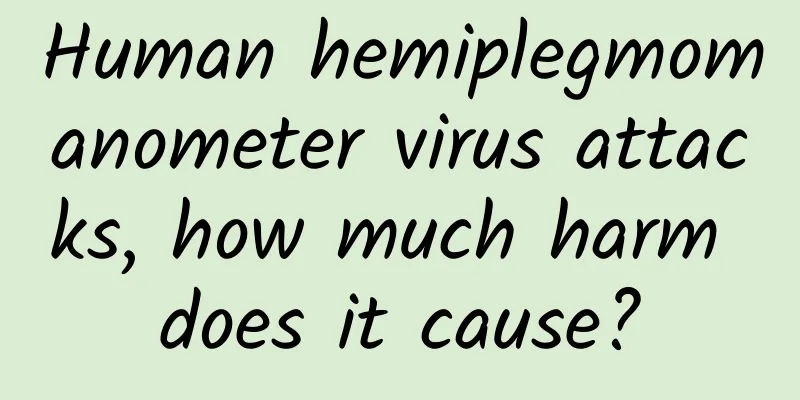Human hemiplegmomanometer virus attacks, how much harm does it cause?

|
Author: Li Chunhong Unit: Zhanjiang Fourth People's Hospital Human metapneumovirus is a common virus that can cause acute respiratory infections. It belongs to the Pneumoviridae family, the Metapneumovirus genus, and is an enveloped single-stranded negative-strand RNA virus. The average diameter of the virus particle is about 200nm, including two genotypes, A and B, which can be further divided into four subtypes, A1, A2, B1, and B2. These subtypes often prevalent at the same time, and there is no significant difference in the transmissibility and pathogenicity of each subtype of the virus. The following is a detailed introduction to the popular science knowledge of human metapneumovirus: 1. Transmission channels Human metapneumovirus is mainly transmitted through droplets and contact. Droplet transmission means that the droplets released by an infected person when coughing or sneezing contain the virus, and others may be infected after inhaling these droplets. Contact transmission refers to close contact with an infected person or objects contaminated by the virus, and then touching one's own body parts, causing the virus to enter the body. 2. Susceptible population: The entire population is susceptible, but the severity of symptoms varies from person to person. Children under 5 years old, the elderly, and people with weakened immune systems may experience more severe symptoms after infection. 3. Clinical manifestations Common symptoms: After being infected with human metapneumovirus, symptoms of upper respiratory tract infection such as fever, cough, nasal congestion, runny nose, and hoarseness are often manifested. 4. According to the course of the disease, it can be divided into the following types: 1. Asymptomatic period: occurs within a few days after viral infection, that is, the incubation period, usually 3 to 6 days. 2. Upper respiratory tract infection symptom period: lasts about 1 week. This period is mainly clinically diagnosed as nasopharyngitis and laryngitis. 3. Remission period: For mild cases, it is often self-limiting, that is, the symptoms will be relieved after a period of time. 4. Lower respiratory tract involvement period (severe disease): For high-risk groups, such as children, the elderly and those with weakened immune function, severe lower respiratory tract infections such as bronchiolitis and severe pneumonia may occur. 5. Diagnostic Methods The virus RNA in respiratory secretions is mainly detected by fluorescence quantitative PCR, viral gene sequencing and other methods. In addition, serological tests and imaging examinations can also assist in diagnosis. 6. Treatment Methods Currently, there is no specific antiviral drug available for the treatment of human metapneumovirus infection. Treatment measures are mainly symptomatic supportive treatment, such as antitussive, antiasthmatic, and antipyretic. 7. Preventive measures: 1. Develop good hygiene habits, such as washing hands frequently and wearing masks. 2. Open windows regularly every day to ventilate and keep the indoor air unobstructed. 3. Avoid close contact with infected people or objects contaminated by the virus. 4. For high-risk groups, such as children, the elderly and those with weakened immune systems, they should pay close attention to changes in their condition and seek medical attention promptly if respiratory symptoms occur. Human metapneumovirus is a prevalent respiratory virus that is common in the entire population. Although there is currently no specific vaccine or antiviral drug available to prevent and treat infection with this virus, the risk of infection can be effectively reduced by taking preventive measures such as adopting good hygiene habits, keeping indoor air clean, and avoiding close contact with infected people. |
<<: The secrets to a healthy heart: Five strategies that start with your diet
Recommend
Everyday Health: Fall Prevention
Fall Prevention There are many elderly people and...
Can I get pregnant if I have cervical cancer?
Cervical cancer is a malignant tumor disease caus...
Is Tesla an electric car or a fuel car? How to charge a Tesla?
Sometimes when we are on the road, we can see a l...
Can pregnant women with cervical spondylosis have massage?
If you observe carefully in life, you will find t...
Things after the typhoon~
Source: Zhejiang Ningbo Fire Department...
White, milky discharge that's a bit itchy
What is the reason for increased leucorrhea and a...
How to cover scars, teach you how to cover scars with makeup
All female friends want to have flawless skin, bu...
Progesterone levels in 2 months of pregnancy
The standard value of progesterone at 5 weeks of ...
Have you been persuaded to drink during the Chinese New Year? This type of people who drink have a higher risk of cancer
During the Spring Festival Friends and family gat...
The dangers of tight underwear
Every woman has a love for beauty and hopes to ha...
Can women exercise during menstruation?
Fitness exercise has many benefits to the body. F...
When is the best time to change the brake fluid? Is it necessary to change the brake fluid?
Brakes are one of the most important parts of a c...
Causes of vaginal tingling like needles
Some women feel a pricking-like pain in their pri...
How to check for cervical hypertrophy? Women must know!
Cervical hypertrophy is a common type of chronic ...
Should I apply a facial mask every day when my skin is dry in winter? Get the right skin care tips for winter
Should I apply a facial mask every day in winter ...









